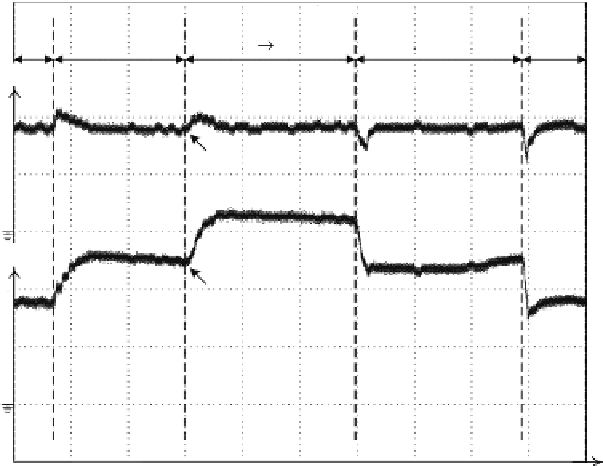Environmental Engineering Reference
In-Depth Information
Main :125 k
10 s/div
∆T
10 K
∆T 10 K,
380 lux
∆T 10 K,
380 lux 1010 lux
∆T 10 K,
1010 lux 380 lux
∆T
10 K
V
/
V
4
Input Voltage
(
V
in
)
2
0
V
/
V
/
Output Voltage
(
4
V
o
)
2
0
0
10
20
30
40
50
60
70
80
Time/sec
FIGURE 5.31
Performance of an HEH system.
in this section, the closed-loop MPP tracker manipulated the duty cycle of the
boost converter to shift back
V
in
and maintain it always at the MPPT voltage
(
V
mppt
=
6V)ofthe HEH system. By doing so, the total power harvested by
the HEH system increased from 190 to 367
3
.
Wat5V,which was more than
the load power consumption.
To enhance the performance of the wireless sensor node, the solar panel
was exposed to a stronger solar illumination of 1010 lux that can be found
in indoor applications like hospitals and factories. Referring to
Figure 5.31
,
for the time period of 30 to 60 s, there was even more electrical power har-
vested from the HEH system at a solar irradiance of 1010 lux and
T
of 10 K
for powering the indoor wireless sensor node. Referring to
Figures 5.17
and
5.20
with operating conditions of 1010 lux and 10 K, the maximum power
obtained by summing the individual MPPs of the thermal energy harvester
and solar panel was 727
W, and the actual harvested power measured from
the two paralleled energy sources was 690
W. The power difference between
the calculated and measured powers, due to impedance mismatch between
two paralleled energy sources, was 35
W. Taking into consideration both the
power difference and the power losses in the voltage-regulating and MPPT
converters, the net harvested power output to the load through the boost con-
verter with efficiency of 90% was 621
W. This verified the harvested power
boost converter connected to the load resistance of 68 k
was around 6.5 V,
and its harvested power was calculated to be 621
W.










Search WWH ::

Custom Search